Affordable Resources
Not everyone of us could afford subscriptions from Chegg, Scribd, Studocu, and Course hero; where mostly the answers for our homework or exam problems, that we have been stuck for a long time, can be found. So I found a way to help others in order for them to afford review materials or exam question and answers for the cheapest price that this site would allow me to set on my documents.
- 17
- 0
- 1
Community
- Abonnés
- Abbonements
18 éléments

Fundamentals of Accounting | Notes | Summary
This document contains the summary of all the information about fundamentals of accounting.
- Resume
- • 39 pages •
This document contains the summary of all the information about fundamentals of accounting.
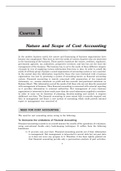
Cost Accounting | Summary
This document contains the summary of all the things that you need to know about cost accounting.
- Resume
- • 28 pages •
This document contains the summary of all the things that you need to know about cost accounting.
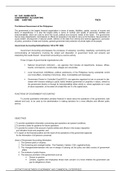
Government Accounting and Auditing Hand-Outs
Government Accounting and Auditing Hand-Outs. Accounting Responsibilities Notes.
- Resume
- • 19 pages •
Government Accounting and Auditing Hand-Outs. Accounting Responsibilities Notes.
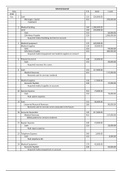
Accounting Journal
Accountancy - General Journal
- Examen
- • 15 pages •
Accountancy - General Journal

Inorganic Chemistry Problems
This contains several Chemistry problems with solutions. Some may show on your chemistry exams or homework.
- Pack
- • 11 éléments •
- Solved: Write the major products, if any, of the following reactions. (24 pts) 1. xs CH 1 2. Ag20, H20, heat 1. butyrichloride, AICI: 2. Dimethylamine, [H") NaBH CN . NH [H+] Cyclopentene 1. H2O 2. PCC, CH2Cl2 1. 2. 3. H30* NH2 p-chlorobenzoic acid 1. Na • Examen
- Solved: A negative ion electrospray ionization (ESI) spectrum of ketoprofen is given in Figure 9.3. Which of the following is not correct? Lütfen birini seçin: a. m/z at 289.1 corresponds to adduct ion b. Cl- or HCOO- are added to neutral ketoprofen c. m/ • Examen
- Solved: Calculate the heat evolved when 42% of 0.488 kg of white phosphorus burn in the air according to the following equation • Examen
- Solved: The solubility product constant (Ksp) of lead(II) iodide is 1.4 x 10 at 25°C. Calculate AG°for the dissociation of lead(II) iodide in -8 water. PbIz(s) = Pb2+ (aq) + 21+ (aq) QUESTION 3 Could there ever be a reaction when AG is greater than 0 a • Examen
- Solved: Construct liquid-vapour and solid-vapour phase boundaries for iodine 12 given the following: ► Enthalpy of vaporization = 41.57 kJ/mol ► Enthalpy of fusion = 14.73 kJ/mol Normal boiling point = 386.8K The sublimation pressure is 52.5 Torr at 113.6 • Examen
- Et plus ….
This contains several Chemistry problems with solutions. Some may show on your chemistry exams or homework.
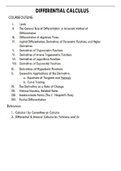
Differential Calculus
Notes and Summary of how to solve different topics of Differential Calculus. The document contains several examples and solutions to show how to solve the following: Limits The General Rule of Differentiation or Increment Method of Differentiation Differentiation of Algebraic Forms Implicit Differentiation, Derivatives of Parametric Functions, and Higher Derivatives Derivatives of Trigonometric Functions Derivatives of Inverse Trigonometric Functions Derivatives of Logarithmic Function...
- Book
- Resume
- • 96 pages •
Notes and Summary of how to solve different topics of Differential Calculus. The document contains several examples and solutions to show how to solve the following: Limits The General Rule of Differentiation or Increment Method of Differentiation Differentiation of Algebraic Forms Implicit Differentiation, Derivatives of Parametric Functions, and Higher Derivatives Derivatives of Trigonometric Functions Derivatives of Inverse Trigonometric Functions Derivatives of Logarithmic Function...

Solved: Experiment 2 Heat of solution of a salt Salt name: Lithium Fluoride (LiF) Fill out the empty boxes of the following table and show your calculations in the space provided below the table (6 points) Hint: you will need to calculate the salt molar m
This document contains the answer from Chegg for the Chemistry Exam Question: Experiment 2 Heat of solution of a salt Salt name: Lithium Fluoride (LiF) Fill out the empty boxes of the following table and show your calculations in the space provided below the table (6 points) Hint: you will need to calculate the salt molar mass from the periodic table Trial 1 Trial 2 Volume of water used, mL 85.00 ml 85.00 ml Initial temperature of water (T1) in °C 24.0 °C 24.0 °C Mass of salt taken in g. 7.0...
- Package deal
- Examen
- • 2 pages •
This document contains the answer from Chegg for the Chemistry Exam Question: Experiment 2 Heat of solution of a salt Salt name: Lithium Fluoride (LiF) Fill out the empty boxes of the following table and show your calculations in the space provided below the table (6 points) Hint: you will need to calculate the salt molar mass from the periodic table Trial 1 Trial 2 Volume of water used, mL 85.00 ml 85.00 ml Initial temperature of water (T1) in °C 24.0 °C 24.0 °C Mass of salt taken in g. 7.0...
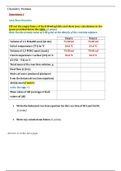
Solved: Experiment 1 Acid/Base Reaction Fill out the empty boxes of the following table and show your calculations in the space provided below the table (6 points) Hint: Use the density value of 1.00 g/ml as the density of the reaction mixture. Trial 1 75
This document contains the answer from Chegg for the Chemistry Exam Question: Experiment 1 Acid/Base Reaction Fill out the empty boxes of the following table and show your calculations in the space provided below the table (6 points) Hint: Use the density value of 1.00 g/ml as the density of the reaction mixture. Trial 1 75.00 ml Trial 2 75.00 ml 24.0 °C 24.0 °C 75.00 ml 75.00 ml 30.0 °C 30.9 °C Volume of 1.5 M NaOH used in ml) Initial temperature (T1) in °C Volume of 1.5 M HCl used in mL)...
- Package deal
- Examen
- • 2 pages •
This document contains the answer from Chegg for the Chemistry Exam Question: Experiment 1 Acid/Base Reaction Fill out the empty boxes of the following table and show your calculations in the space provided below the table (6 points) Hint: Use the density value of 1.00 g/ml as the density of the reaction mixture. Trial 1 75.00 ml Trial 2 75.00 ml 24.0 °C 24.0 °C 75.00 ml 75.00 ml 30.0 °C 30.9 °C Volume of 1.5 M NaOH used in ml) Initial temperature (T1) in °C Volume of 1.5 M HCl used in mL)...
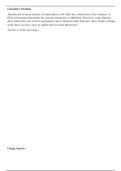
Solved: Aphidicolin-resistant mutants of mammalian cells often have alter- ations in the structure of DNA polymerase e that render the enzyme insensitive to inhibition. However, some mutants show alterations, not in DNA polymerase but in ribonucleotide re
This document contains the answer from Chegg for the Chemistry Exam Question: Aphidicolin-resistant mutants of mammalian cells often have alter- ations in the structure of DNA polymerase e that render the enzyme insensitive to inhibition. However, some mutants show alterations, not in DNA polymerase but in ribonucleotide reductase. How might a change in the latter enzyme cause an aphidicolin-resistant phenotype?
- Package deal
- Examen
- • 3 pages •
This document contains the answer from Chegg for the Chemistry Exam Question: Aphidicolin-resistant mutants of mammalian cells often have alter- ations in the structure of DNA polymerase e that render the enzyme insensitive to inhibition. However, some mutants show alterations, not in DNA polymerase but in ribonucleotide reductase. How might a change in the latter enzyme cause an aphidicolin-resistant phenotype?

Solved: Fatty acid biosynthesis begins with the condensation of a two-carbon acetyl residue from acetyl-CoA and oxaloacetate, while oxidation leads to the release of two carbon units acetyl-CoA and fatty acyl-CoA. However, these two processes are not simp
This document contains the answer from Chegg for the Chemistry Exam Question: Fatty acid biosynthesis begins with the condensation of a two-carbon acetyl residue from acetyl-CoA and oxaloacetate, while oxidation leads to the release of two carbon units acetyl-CoA and fatty acyl-CoA. However, these two processes are not simple reversal. Compare and contrast these two pathways.
- Package deal
- Examen
- • 3 pages •
This document contains the answer from Chegg for the Chemistry Exam Question: Fatty acid biosynthesis begins with the condensation of a two-carbon acetyl residue from acetyl-CoA and oxaloacetate, while oxidation leads to the release of two carbon units acetyl-CoA and fatty acyl-CoA. However, these two processes are not simple reversal. Compare and contrast these two pathways.
